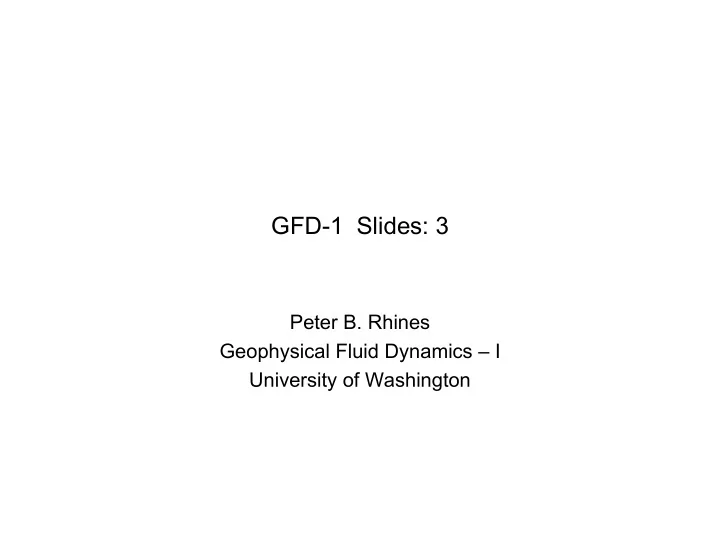

GFD-1 Slides: 3 Peter B. Rhines Geophysical Fluid Dynamics – I University of Washington
CO2 flow over a mountain...made visible by water vapor condensed in it. This downslope wind jet is a common feature of fast flows...where the flow speed reaches √ (gH) at the crest of the mountain. The surface of the white gas is approximately a ‘pressure gauge’ the downslope to the right showing the rightward force which is needed to accelerate the flow, which concentrates into the fast downslope jet.
Taylor columns or ‘curtains’ in a uniform-density rotating fluid. This orange wake was produced as flow was forced over the circular mountain
viewed from above the dye sheets become lines
Pressure field in flow past a circular cylinder...with no Earth’s rotation this is potential flow with zero vorticity. The high pressures occur near the stagnation points on the upstream and downstream sides of the cylinder, while low pressure occurs on left and right sides of the cylinder, all told by Bernoulli equation. In real flows separation occurs so that the pressure does not ‘recover’ to high values on the lee side of the obstacle. Then, the high pressure upstream causes a net drag force on the cylinder.
The same flow occurs with Earth’s rotation (because it is entirely 2-dimensional in this model), yet the pressure has an added component ρ f ψ , which is constant along streamlines and shows a strong gradient across the flow so as to balance the rightward Coriolis force on the mean flow.
Surface air temperature, 2 Jan 1993, showing the dome of cold polar air extending down through Canada, accompanying strong westerly winds and cold-air outbreak that runs along the eastern slope of the Rocky Mountains, which can resist the Coriolis force to the west.
Sakai gravity waves (left); Kelvin waves (right)
Equatorial Kelvin waves and the MJO Matthews, Slingo, Hoskins+Innes, QJRoyMetSoc, 1999
Time series showing geostrophic adjustment in a rectangular channel, where the deeper green fluid is held back by a barrier (top panel) which is removed ((2d panel); a geostrophic flow develops as the gravitational ‘slumping’ to the right (“east”) is rotated southward by Coriolis forces. Then this flow is deflected by the wall to run eastward...the way it wanted to in the first place. But long before the green fluid moves along the boundary, a Kelvin wave has sped round the boundary (see the deflection of the blue dye streaks). It takes many hours for the APE in the initial conditions to be expended and the fluid to come back to rest.
The surface pressure and 500 HPa pressure fields illustrate the strong variation in atmospheric circulation with height: try to sketch the temperature field that allows this to happen, through the thermal wind equation. This is winter 1993 average (Jan-Feb-Mar) NCEP Reanalysis data
Gale force winds were supplied by fast-moving lows arriving from the Great Lakes, where a deep trough in the jetstream was stationary for some days. Three hurricanes reached Greenland in the 4 weeks prior to launch, energizing when they passed beneath the jetstream
TP Rossby waves
Erika Dan section line
Erika Dan section (temperature) 60N (Worthington-Wright Atlas) This is a section from Labrador (left) to the southern tip of Greenland (Cape Farewell), across the Reykjanes Ridge near Iceland, to Rockall Bank and finally Ireland on the right. The warm upper water is flowing northward, part of it headed for the Arctic. Very cold deep waters flow southward in return, and lean against the continental slopes to balance Coriolis. Compare the hydrostatic pressure at a deep levels here, and you will see the change in geostrophic velocity that corresponds to the change from northward flow to weak or souhward flow in the deep regions.
2003 temperature section across the Labrador Sea (the lefthand basin in the Erika Dan section above).
Recommend
More recommend